I deal with an unexpected challenge, see some jaw-droppingly beautiful birds, and fall into listing mode
Highlights from Colombia: Days 10-13
Okay, I have a confession to make. By this point in the trip, I was pretty sick. Illness had been gradually making its way through our group, and I was about the 7th or 8th person to succumb. By day 10 my throat was on fire, my head was congested, and my body was intermittently wracked by coughs. I’ve debated writing about getting sick, as it’s not really how I want to remember my time in Colombia, but it was definitely part of the trip. Thankfully even during the worst of it, I still had a decent amount of energy—at least in the morning. Also, our guide Adam had the foresight to pack a healthy supply of Dayquil. And finally, we were outdoors, fairly isolated, and surrounded by amazing birds. I just kept right on birding.
Day 10: La Florida el Bosque de las Aves and Araucana Lodge
Highlights of the Day: Every bird at La Florida
This was a day I’d been looking forward to all trip. La Florida is home to two amazing Colombian endemics, the Multicolored Tanager and the Chestnut Wood-Quail, and I’d been fawning over both of them for weeks. I mean, just check out this picture of the Wood-Quails.
After a quick breakfast at Araucana and some heroic efforts on our guides’ part to pull our easily distracted group away from the grounds, we got into the van and headed down the road to La Florida.
As soon as we pulled up, I knew it was going to be an amazing day. La Florida, which is tucked into a forested mountain slope, was shrouded in clouds and yet lit from the sun above, and that gave everything a lovely golden glow.
It was like stepping into a dream.
La Florida's owners enhanced the magical atmosphere with their warm smiles and generous servings of delicious coffee and hot chocolate. Within minutes of settling into our appointed spots at the feeders, a pair of Red-headed Barbets came in.


Next up, our dreamed-for Multicolored Tanagers. When they flew in, a hush fell over the group as we all whisper-gasped “Multicolored Tanager.”
All the while, I was keeping an eye on the Chestnut Wood-Quail feeders to my left, and noticed Roger was keeping an eye on it too. I also noticed he had that look guides get when they’re worried a group will miss a target bird. Once I had my fill of photos at the first station (so many gorgeous tanagers kept dropping in!), I moved to the Wood-Quail feeder to keep watch with him.
That was probably my best decision of the day. While we watched and waited, I got to chat with Roger and learn a bit more about his life outside of birding and guiding, which was an absolute delight. All the while, we watched and listened for birds, so we got a brief look at a Chestnut-capped Brushfinch and heard a South American Leaftosser and a Lineated Foliage-gleaner.
On a few different occasions, I caught glimpses of what looked like the Wood-Quails in the foliage behind the feeders, but they were the briefest of looks. Just as I resigned myself to missing my dream borb, one of the staff walked by and saw the Wood-Quails hiding behind a large rock. That had been them walking down the slope, and they’d probably been within feet of us for quite some time. They were gently coaxed into coming out into the open--first the female, and then many minutes later the male. Absolutely borbilicious!


After many wonderful minutes with the Wood-Quails we pulled ourselves away for a walk down the road to look for new species. We encountered a mixed flock not far down the road and I even managed to find one of our targets--the Metallic Green Tanager! This bird is an absolutely stunner, of which I have exactly zero in-focus shots.
Next up was my other dream bird—the Northern Chestnut-breasted Wren. One was singing VERY close to the road and captivated the entire group with their delightfully spooky song. What a bird!
After a delicious lunch we made our way to the hummingbird feeders where we were greeted by White-booted Racket-tails, Long-tailed Sylphs, Purple-throated Woodstars, Crowned Woodnymphs, and many others. We even got to feed them from portable syringe feeders and I had a Brown Violetear, Purple-throated Woodstar AND a White-booted Racket-tail come to mine. Locking eyes with these tiny but fierce birds was one of the best experiences of the day. Video courtesy of Adam Sell
I think the only reason we were able to eventually pull ourselves away from La Florida is that we knew we’d be going back to the lovely grounds of Araucana.
Plus, we were all exhausted.
Once back at the lodge we grabbed some beers and settled in at Araucana’s feeders. Roger and Adam restocked them with bananas for the tanagers and barbets and nectar for the hummingbirds, and we had a blast naming the feeders so we could easily call out locations of birds. Our names were efficient if not creative. Banana 1, stump, Banana 2, Banana 3. You get the drift.
I tried to keep up with everyone else, but after calling out one too many birds and joining in on a heated debate about whether the Purple-throated Woodstar was actually at 11 o’clock or 12 o’clock on the palm, I completely lost my voice.
I feel into bed exhausted a few hours later, and despite Araucana’s extremely comfortable accommodations, I had a terrible night’s sleep. But since I can never manage to stop birding, even when sick and utterly exhausted, I heard a Tropical Screech Owl calling outside my room at 1:30 am. Suddenly that terrible night’s sleep wasn’t so terrible after all.
Day 11: Finca el Descanso (Doña Dora) and Araucana Lodge
Highlights of the Day: Wacky lekking birds, a moth trap, and an unexpected sparrow
While I’d only eeked out a few hours of sleep, I was ready to go by our planned departure time of 4:30 am. Our birding destination for the day was Finca el Descanso (Doña Dora). What is now a mecca for birders and bird photographers started out as Dora Londoño’s roadside empanada stand in the 1990s. Fortuitously, Doña Dora started feeding birds behind her restaurant, attracted Toucan Barbets1, and the rest is history.
We were definitely there to see the Toucan Barbet, but we were there so very early to hike to the lek of the Andean Cock-of-the-rock.
After briefly greeting Doña Dora and her family, we carefully made our way down to the lek. We’d been prepped this was going to be a tricky hike—it was a steep and slippery downhill path, we’d be doing most of it in the dark, and it was going to take us at least 30 minutes. Armed with headlamps and flashlights, we carefully picked our way down the trail. Other birds were waking up and calling, but they’d just have to wait.
When we finally reached the lek, one of the males was sitting right there: larger than expected, brilliantly red, and just as bizzare as they look in their pictures. It was surreal.
I didn’t get any audio or video while at the lek, but here’s a good example of what the action looked and sounded like. Being surrounded by these strange calls in a dark misty cloud forest made the experience even more surreal.
On the hike back up from the lek we stopped at a moth trap which had so many crazy cool moths. The tanagers, flycatchers and others thought so too, and they came in to feast on the moths as we watched and caught our breaths. Joining the feeding frenzy was a gorgeous and unexpected Slaty-capped Shrike-Vireo, Black-headed Tody-Flycatcher (so wee!), Ornate Flycatcher, and a Scale-crested Pygmy-Tyrant.
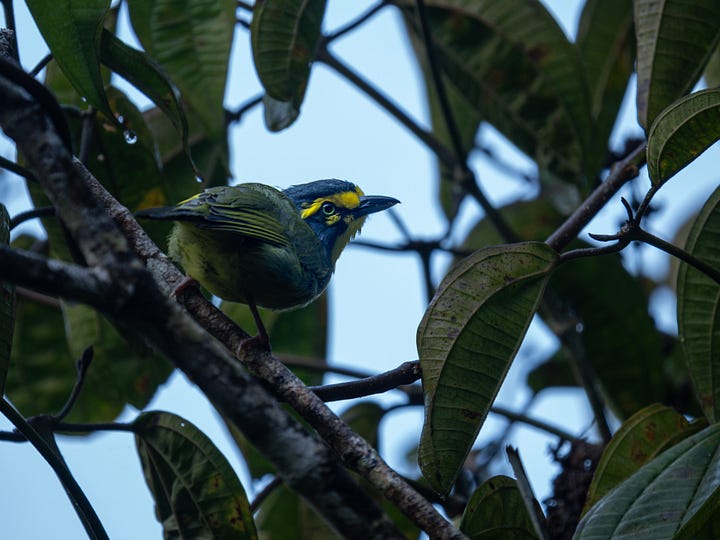
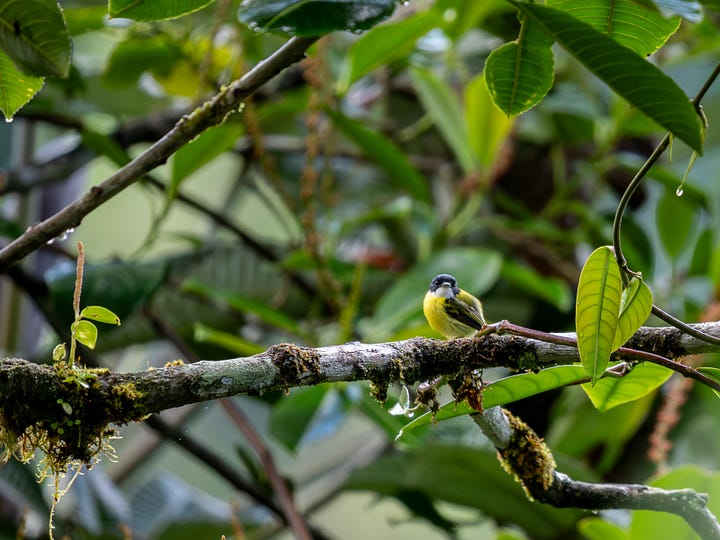

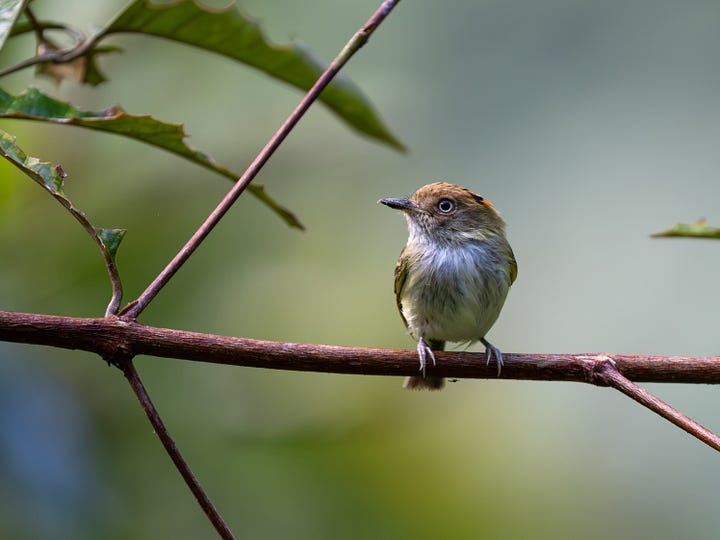
When we finally made it back to the top (made somewhat more challenging by my head cold) we got to visit the hummingbird feeders on the upper deck of the restaurant and got our first glimpse of an Empress Brilliant.
Following a wonderful breakfast of cheese empanadas, during which I got buzzed by a Purple-crowned Fairy (!!), we encountered so many other amazing birds. There are really too many to list here, but the true show stoppers of the day were the Toucan Barbet, Glistening Green Tanager (this one also made us whisper-gasp “ooh, Glistening Green”), and Silver-throated and Rufous-throated Tanagers.
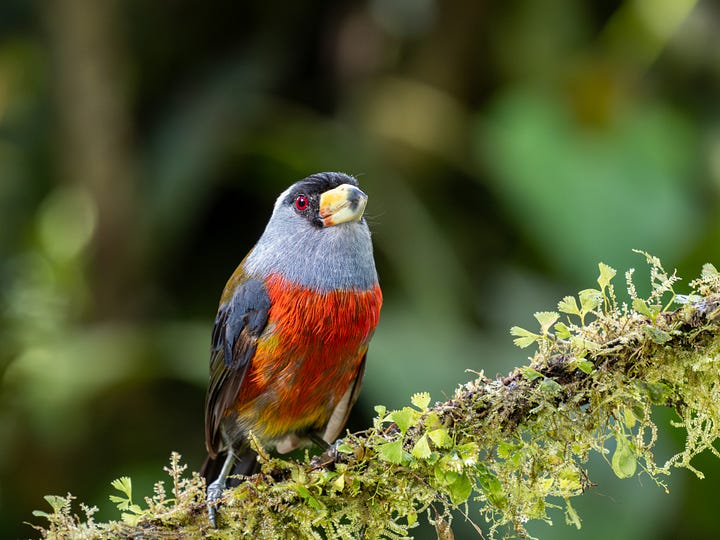

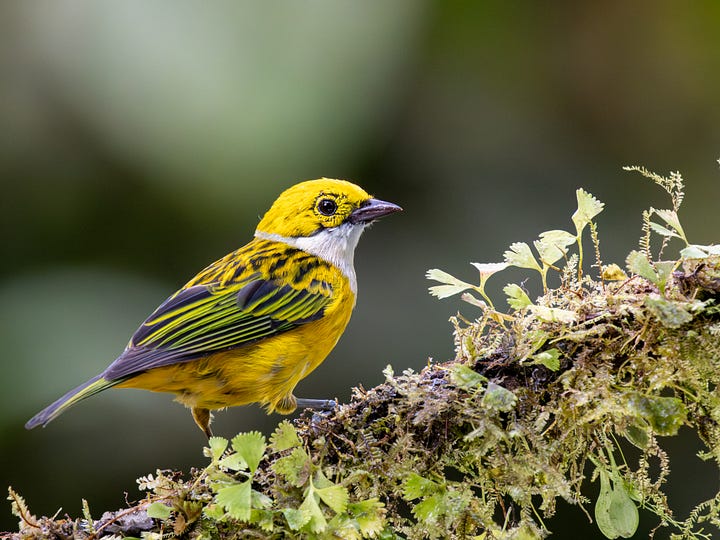

We eventually bid a fond farewell to Doña Dora to explore the surrounding roadside cliffs where Roger had reliably found Lyre-tailed Nightjars roosting. Well, birds are reliable only to a certain point—there were no nightjars to be found that day.
While consoling ourselves along the side of the road, one of Doña Dora’s sons spotted us. I’m not sure whether he took pity on us or if he just wanted to spread more bird joy, but he shared that he’d been feeding Olive Finches down the road where he was building a house. What!?!? Olive Finches are a rare New World Sparrow,2 particularly tricky because they hang out near rushing rivers at the bottom of steep ravines where it’s difficult to see AND hear them. What an unexpected opportunity! Our luck was back, and shortly after our arrival one came in and sang for MINUTES non-stop. Roger was able to grab this video through his scope, and you can not only hear the Olive Finch, you can here me talking about trying to take a picture, which I absolutely failed to do! Video courtesy of Roger Rodrguez Ardila
Day 12: Last morning at Araucana, San Felipe, and Laguna de Sonso
Highlights of the Day: Some absolutely stunning hummingbirds and lagoon birding
Our time at Araucana was at an end, but I’d finally had a good night’s sleep and was able to squeeze in a bit of birding while packing. A pair of Buff-rumped Warblers danced and sang on my patio while a Scale-crested Pygmy-Tyrant sang from the bamboo along with a Chivi Vireo and Yellow backed Oriole. Here’s a bit of that view and soundscape:
Our next destination was San Felipe, which was lovely and chill. The owners greeted us and served us hot chocolate while we watched their feeders, a tradition I’d come to treasure.
But while the vibes at San Felipe were chill, I was anything but. I had just realized that morning that I had 985 species on my life list, therefore seeing my 1000th bird in Colombia was actually within reach! I used the last dregs of my voice to share that bit of news with the group. Adam and Roger thought there was a chance we could pick up 15 new species, but it was going to be close!
While we enjoyed our time at San Felipe (their feeders and hospitality were top notch), as the temperatures climbed and the clouds dissipated, the birds got quiet. The only new species we managed to pick up was a Plain Antvireo. After a delicious lunch, we hit the road to make it to our next destination, Laguna de Sonso.
Roger surprised us along the way when he informed us that one of the community workers there, Nathaly, had a reliable spot for Ruby Topaz Hummingbirds. In fact, she confirmed seeing them that day. We were familiar with this species, having scrolled past it in Merlin all trip, but we never thought we’d actually get to see one. I think our heads collectively exploded.
Roger followed this amazing news with a well planned speech, as he’d come to know our group so well. “Okay, guys!” he said “You’ve been training for this moment for the last 12 days. We have 3 missions: 1: super fast bathroom stop! 2: Ruby topaz! 3: bird the lagoons before we lose the light!”
Mission 1: ✔️
Mission 2: Oh my god! ✔️
Nathaly guided us to the field of flowers she’d been tending for the Ruby Topaz, and they were absolutely stunning. My only regret here is I was so focused on finding other birds that I didn’t spend nearly enough time with these hummingbirds. BUT, in my defense, there was a Dwarf Cuckoo calling from the trees, and so many other birds to see. I had fully entered listing mode.
Nathaly next took us into Laguna de Sonso, and this time we got to bird it from the inside instead of along the scary road from Day 9. She first showed us a roosting Tropical Screech Owl and we saw and heard Greater Ani from across the lagoon.
Next up—HORNED SCREAMERS!
A Pied Water-Tyrant landed nearby, Nancy somehow found a Pinnated Bittern, and Nathaly found an Oriole Blackbird. The lifers kept on coming, both those we heard, like the Great Antshrike, and those we saw, like the Brown-chested Martin. I was counting each one, but as our time at Laguna de Sonso came to a close and we spotted our last new species, the Jet Antbird, I thought I was still a few birds short of 1000. Seeing the disappointment on Roger’s face when he learned I’d barely missed my target was more heartbreaking than actually missing it. But, as I shared with him, I’d had a fantastic time and we still saw a ton of birds. I was content.
Mission 3: ✔️
Day 13: Departure from Colombia
Highlight of the day: Reaching a birding milestone
We packed up and left Colombia the following day, but not until after a walk around Calí where I managed to see one more new species, the Orange-chinned Parakeet. That brought me one step closer to my 1000th bird, and just as I was wondering which North American species would make that milestone, Cary shared some exciting news. He’d found at least one bird that was on our daily paper checklist that had been accidentally left off of eBird. If there was one missing, there could be more!
We spent our time on the plane scrolling through our lists, and picked up several more species that had been accidentally missed: White-capped Tanager, Crested Ant-Tanager, Mottled Owl. ✔️✔️✔️
I had seen my 1000th life bird in Colombia after all, and it was the last bird we found at Laguna de Sonso—the Jet Antbird. This bird had briefly popped into view after singing away for minutes. Here’s my photo of him:
And while I didn’t manage to get any recordings, here’s what he sounded like:
Jerome Fischer, XC560189. Accessible at www.xeno-canto.org/560189
While I could continue gushing about Colombia for many other posts, I’ll leave it here for now. It was a fantastic trip, made all the more wonderful by the people I got to share it with, and I’ll remember it fondly for the rest of my life. All in all I encountered 396 species and picked up 336 lifers. Some I got to really spend time with and enjoy, others passed in the blink of an eye. If you’re all interested in seeing the entire list or more of my photos from the trip, check out our eBird trip report. And thanks so much for reading.
💜,
Kelly
I’m curious, have you ever been to Colombia? If not, are you interested in visiting now? What’s your most recent birding milestone? Please share in the comments.
Toucan Barbets are a near endemic which sings in duet. As Hilty describes it, females and males sing on different pitches and out of synch, producing distinct syncopation, recalling French ambulances 🚑
Yes, I know its name says finch but it’s really a sparrow
All media taken by me, Kelly C. Ballantyne, unless otherwise indicated


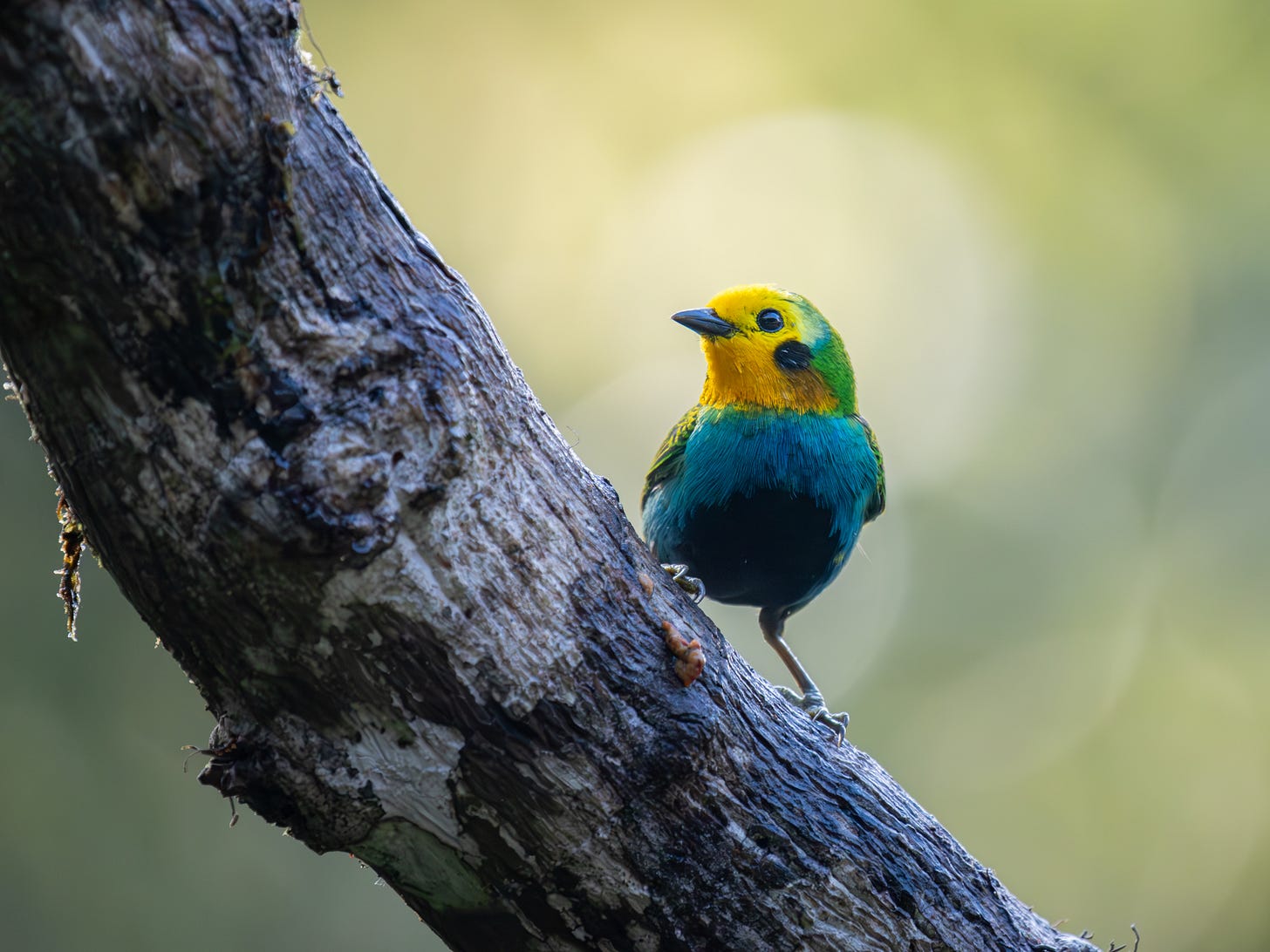

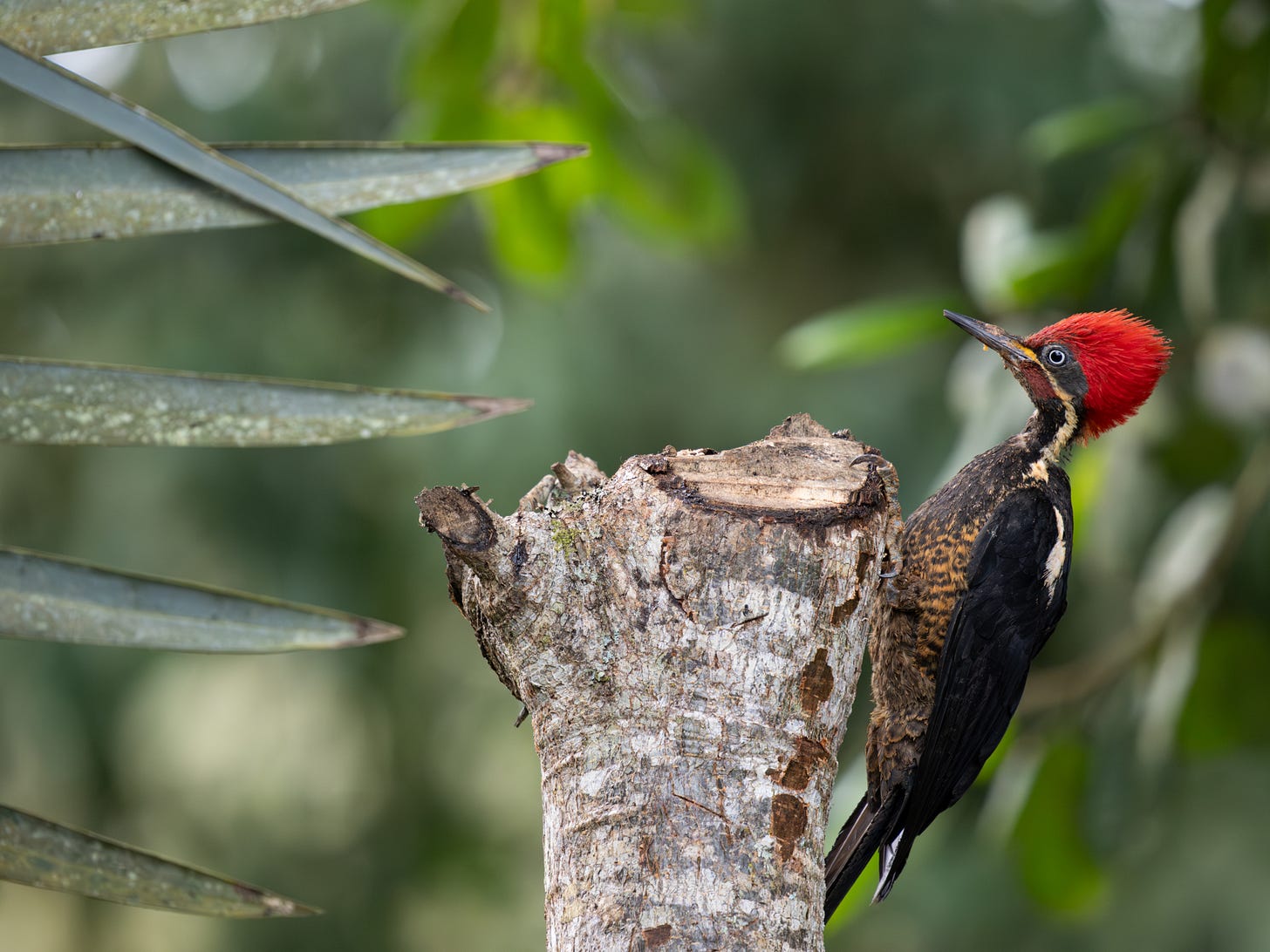

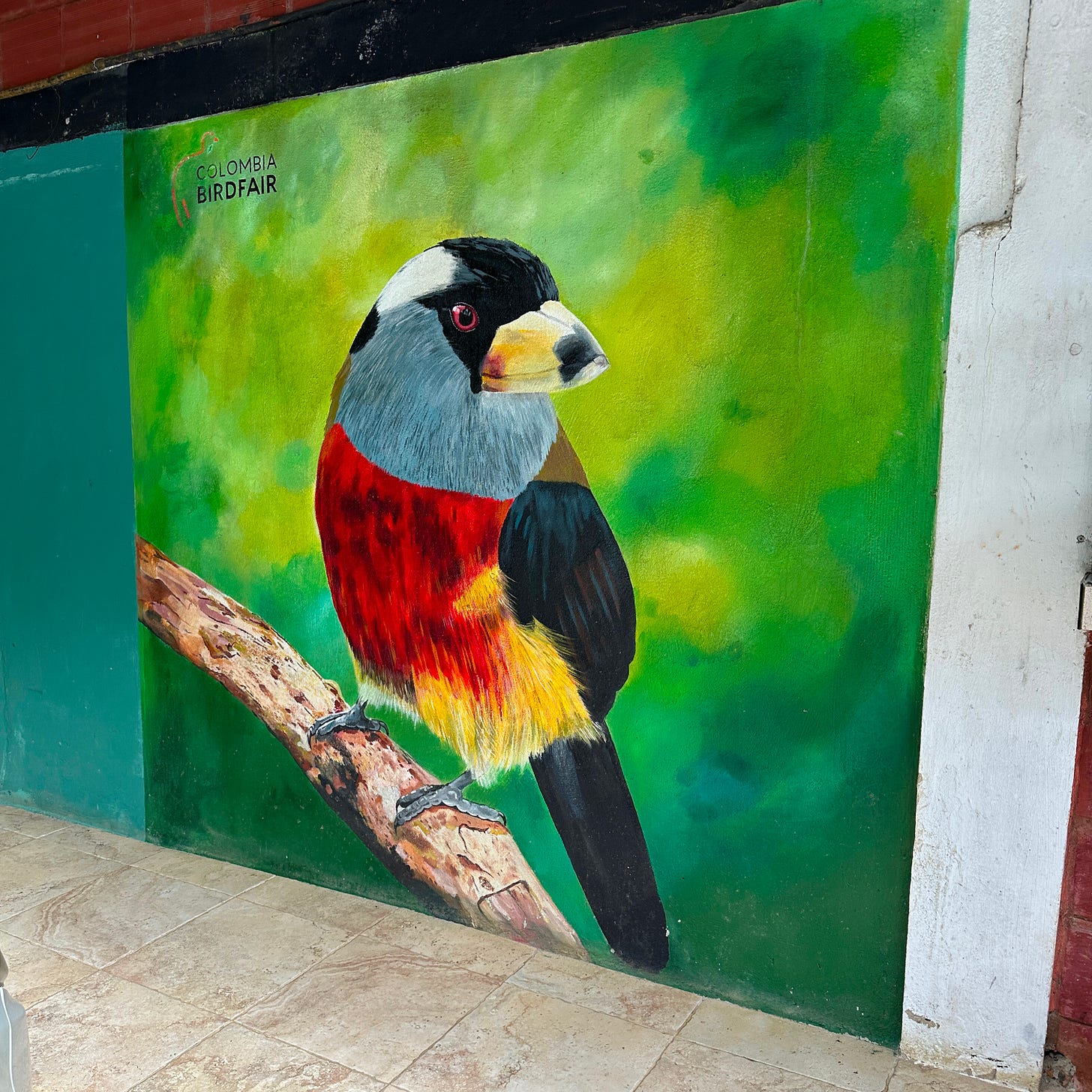
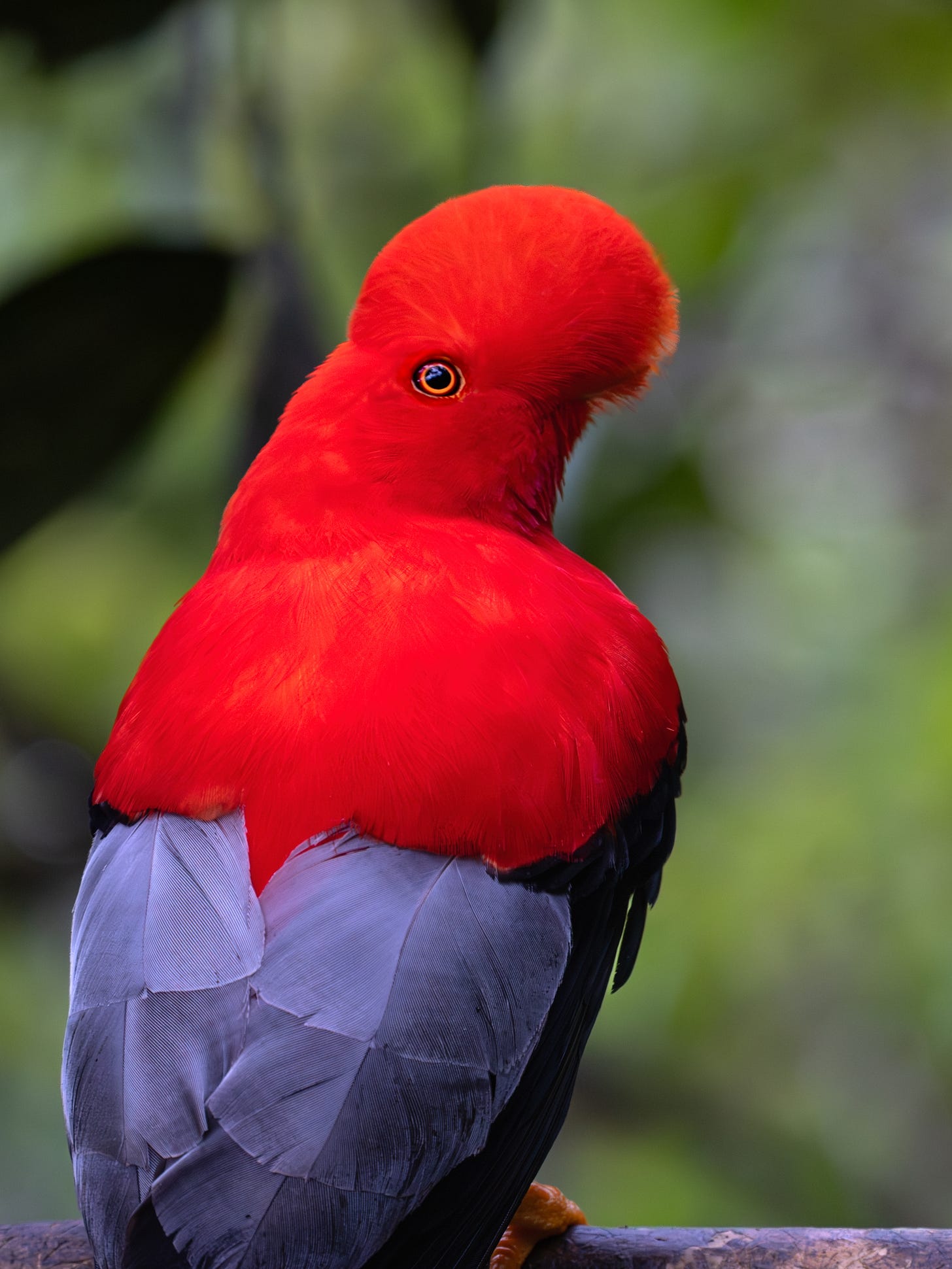
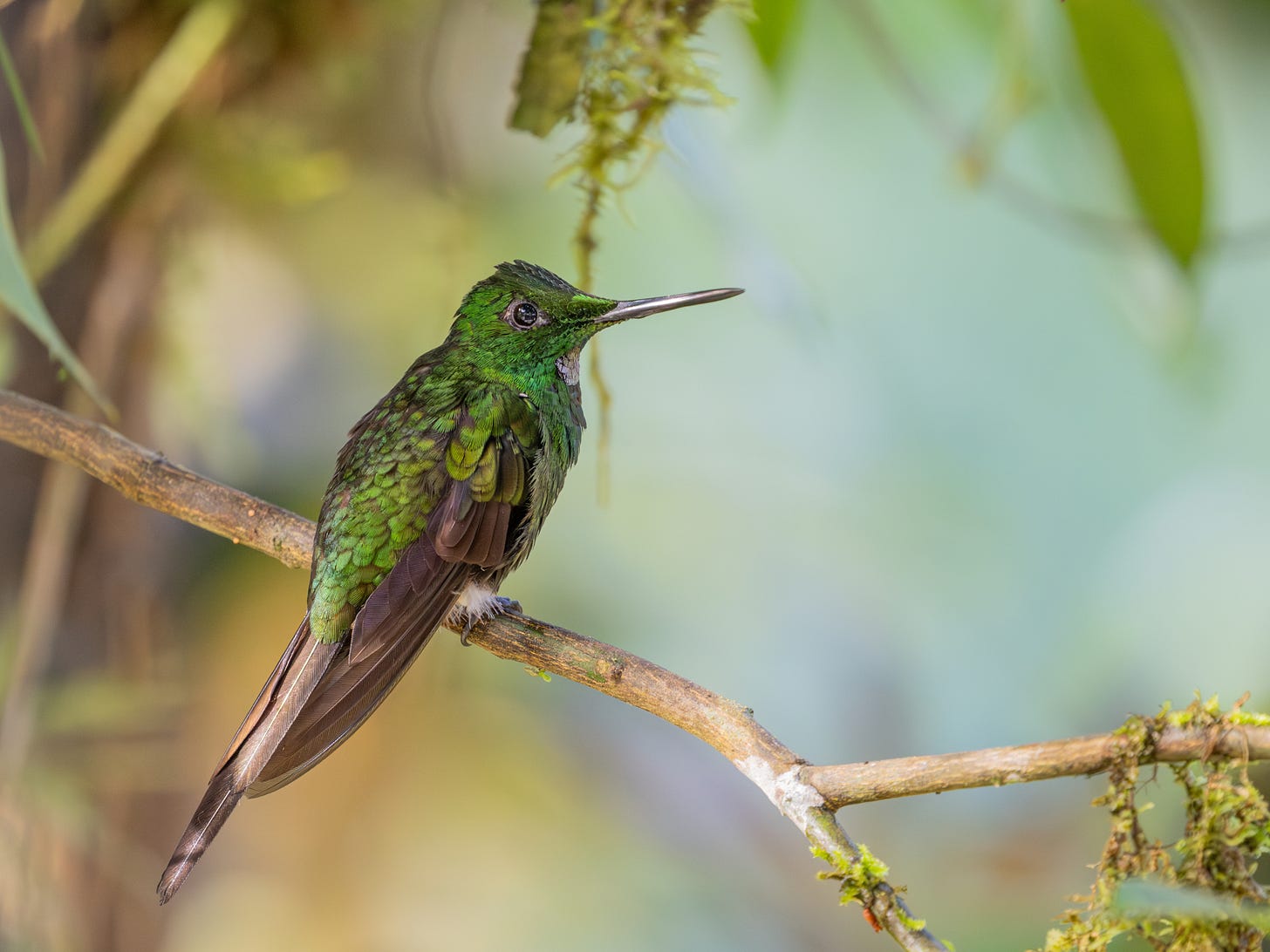

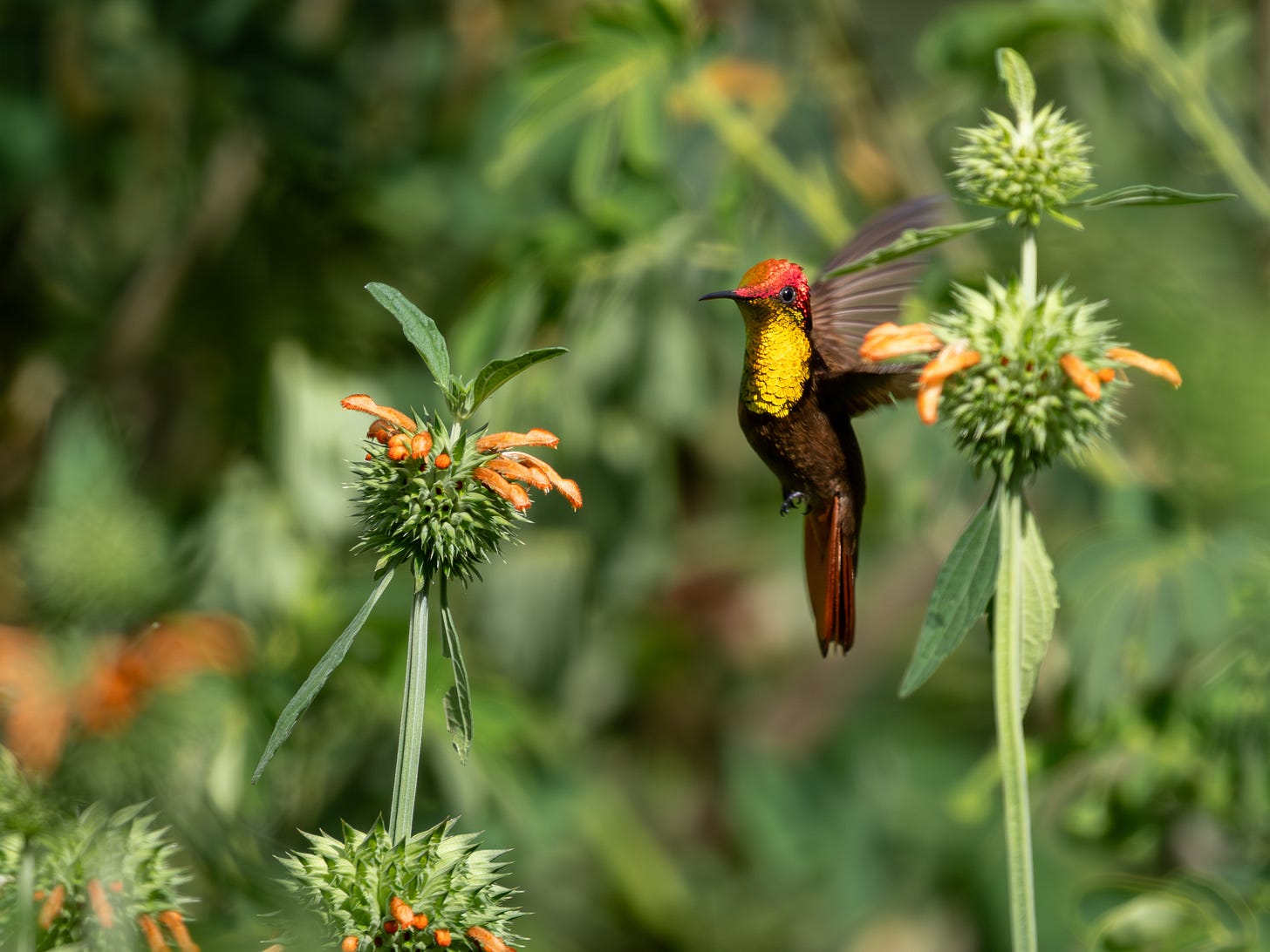

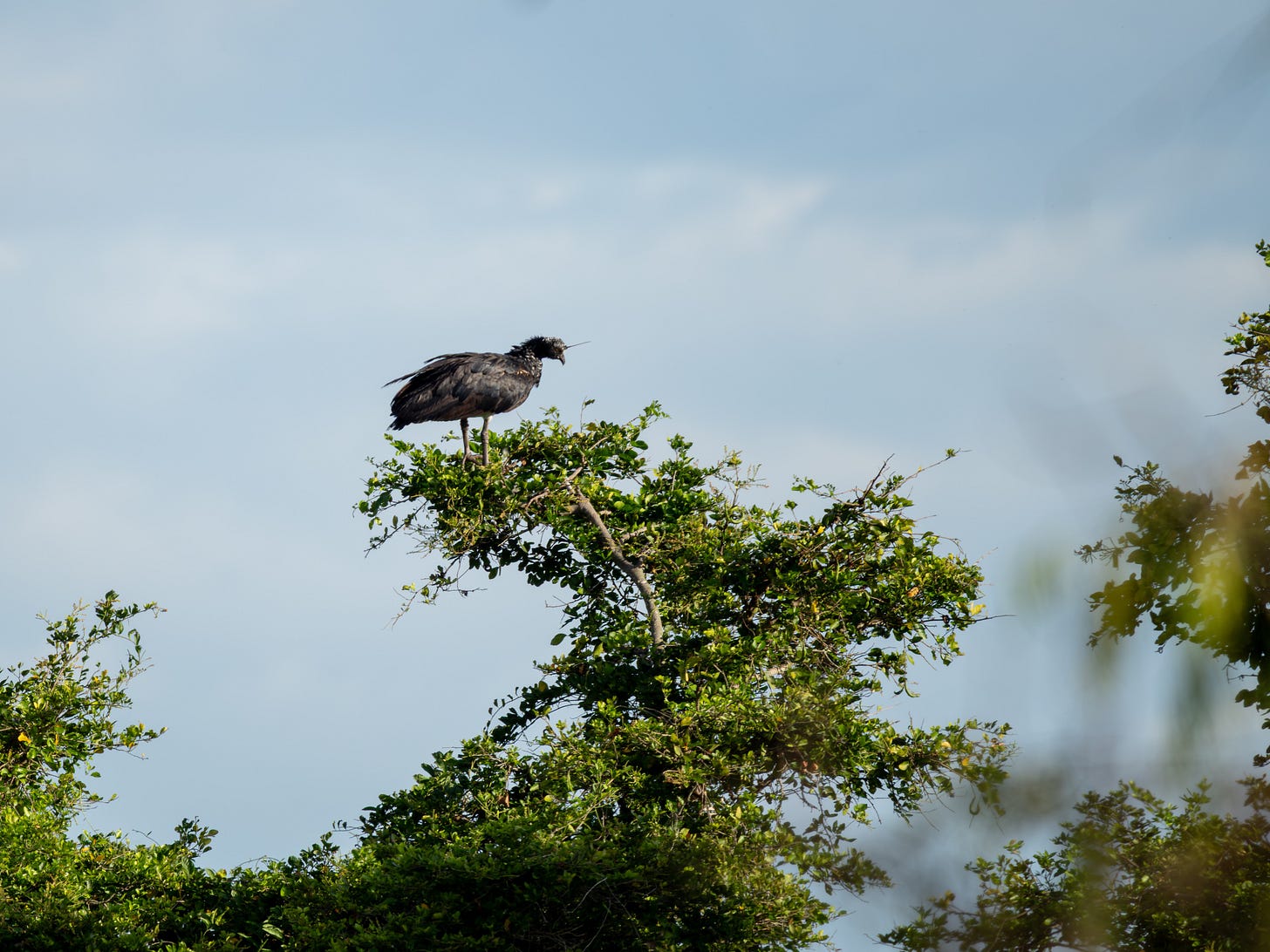

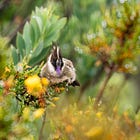

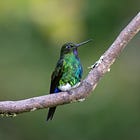
Oh my god, that Ruby Topaz. I NEED to see that in my life. Maybe my favorite of all the amazing birds you've shared.
And holy shit do I need to get to Colombia. I mean duh. But yeah, after reading these posts... next big birding destination for sure.
Enjoyed seeing via this post, so many birds I wouldn't otherwise get to see! Thank you for sharing !